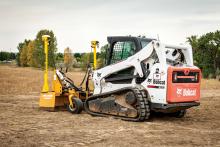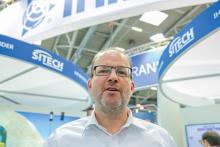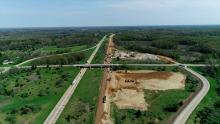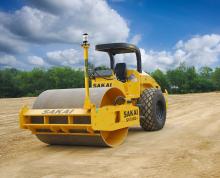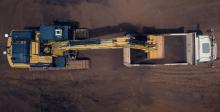At what point does ‘some technology’ become ‘enough technology’?
Less than four years ago industry publications were filled with a persistent message, the reluctance of UK based contractors to adopt machine control to the same extent as near European neighbours, particularly close ones such as Ireland and Holland. However from 2009 onwards we have seen a huge shift in demand for machine control as the success of high profile road and rail jobs such as the M25 widening scheme and Airdrie – Bathgate rail
Machine control technologies allow precise operation
At what point does ‘some technology’ become ‘enough technology’?
Less than four years ago industry publications were filled with a persistent message, the reluctance of UK based contractors to adopt machine control to the same extent as near European neighbours, particularly close ones such as Ireland and Holland. However from 2009 onwards we have seen a huge shift in demand for machine control as the success of high profile road and rail jobs such as the M25 widening scheme and Airdrie – Bathgate rail link jobs have encouraged others to follow suit.
Over the last four years machine control technology has become firmly established as the preferred approach for earthworks contractors on major road and rail jobs. Machine control has finally taken off and we’re starting to see the familiar pattern of a technology reaching maturity along with a wider acceptance as those outside the ‘core’ users investigate what machine control technology can bring to their area of expertise. In 2012 we have seen 3D machine control successfully used on drainage jobs, house building jobs and on excavators with rockwheels to profile rock faces to 3D design on a road project.
Of course during this time system manufacturers haven’t sat back and just watched the market grow; they’ve been busy developing technology to bring new efficiencies to site.
2122 Trimble’s Connected Site solution is typical of this. The Trimble promise is of a site where two way real-time communication will enable site managers to monitor the utilisation of equipment, track results instantly, enable smarter decisions and manage multiple job sites from a single location. In short, remove elements of the job that can be costly. Whilst the technology is still in its infancy, other areas of Europe, in particular Scandinavia, have an encouraging take up of one aspect of this technology which enables job sites to be monitored from a single location. The technology that facilitates this is Trimble’s SNM940 Connected Site Gateway.
Mounted on heavy equipment, the SNM940 Radio is the first communications system that integrates grade control data communications, remote GNSS data corrections and asset management into a single device. It works by receiving GNSS correction data broadcast over the internet with the addition of a Trimble TCC (Trimble Connected Community) License subscription or via a local WiFi network. It can also utilise the Trimble VRS network to receive nationwide GNSS data corrections for contractors not geographically based in one location or site, enabling the machine to work anywhere at any time. The single most significant benefit is that the site manager can send updated design information to multiple machines and multiple sites from any location as long as there is access to the internet.
The technology is straightforward and the benefits tangible and yet take up in the UK has yet to take off. Trimble’s Application Engineer for Heavy Civil Construction in EAME, Dwayne Rosie, has his own thoughts on the subject. “My theory is that UK companies aren’t investing yet as they have no motivation to change – existing methods work, even if they aren’t wholly efficient. It is the same slower approach that we saw initially with machine control. However some people are aware of the savings involved (generally in terms of their time and driving) so are advocates of the technology but have to sell the idea to higher management who pay for it all. While there are savings to be made on wireless data transfer it is not as easy to see when compared to watching a machine cut to grade. I think this will slowly catch on in much the same way that machine control became the norm. People will get used to seeing the technology in action as the ‘pioneers’ use it, like it and finally depend upon it. Word will then spread through other construction companies.”
In short, Dwayne predicts that we can expect so see this technology go through exactly the same cycle of exposure, use, acceptance and then diversification as we saw with machine control, a process that will be assisted by those willing to lead the way.
Although WM Donald was an early adopter of Robotic Total Station technology and a long term user of Trimble systems, up until 12 months ago the company had never used machine control on any of its projects. Keen to change this situation was Mike Meldrum who runs the site engineering side of operations covering everything from the day to day management of machines to preparing the drawings and models.
Although there were mixed reactions from both the company’s operators and management, some sceptical, some keen, Mike contacted KOREC to arrange a demonstration of the Trimble GCS900 3D GPS machine control system. “We’ve been loyal to Trimble since our days of using Geodimeter total stations and were aware of many companies in Scotland successfully using machine control. This is current, tried and tested technology and it definitely felt like the time was right for us to investigate further.”
An initial system was purchased for muck shifting and for trialling on house foundations and was fitted onto one of WM Donald’s EC2402394 Volvo excavators. Mike reports that following some brief training, including Trimble’s on-line training, even the biggest sceptics amongst the operators were won over as the time and cost savings became apparent. “The systems are pretty intuitive to use and an additional bonus for the operators was the new CB460 control box which is Trimble’s premium in cab display. Once they saw that they didn’t need an engineer to reposition a knocked out peg and that things were going in the right place at the right height, they stopped regarding the system as a gimmick to lay on them and now I don’t think they’d like it I took it off them! They now ask for things…new drawings…new designs, and are more involved than ever which means there is always something for them to do whereas in the past work would have come to a halt. Mistakes have been learnt from and the operators have been able to see clear benefits as their proficiency increases. For example, they are no longer over breaking rock on sewers and plot platforms or over digging. We can now breakdown straight to formation on sewer tracks and by keeping tracks tighter to the line, we can also save on pipe bedding. On the housing foundation side we can pretty well leave an operator to dig out the whole foundation area on his own and the work will be spot on which is a big time saving for us. This is especially so on deep excavations and on poor ground where lines would normally have been lost and require remarking. We’re learning all the time.”
Two months later, another two systems were purchased to coincide with the upgrade of an EC220 and EC240 Volvo excavator as part of WM Donald’s rolling upgrade programme.
The company also opted to use Trimble’s VRS Now Service for its real-time GPS corrections rather than a base station – a key decision in preparation for its move towards becoming the UK’s first company to take up a Trimble Connected Community License.
With VRS Now, there is no base station hardware involved to lose or damage, no engineer required to set up and take down the base, daily, and no time wasted recharging its batteries – all major benefits for a company that moves its machines from site to site.
“If you’re running VRS, a TCC license is a no brainer and for us it was always something we were going to do after we were bedded in with the three machines with the GCS900 systems,” explains Mike. “Of course I understand that VRS isn’t the perfect solution for everyone, but here in Aberdeen our mobile phone coverage is excellent, especially so now we are using the roaming T-mobile SIM cards which cover several networks seamlessly, and although the machines have radios in their base kits in case there is no phone signal, we’ve never had to use them. If you’ve got the connection, you may as well use it! Our set up is now completely fluid and using the SNM940 and TCC licenses has become part of our day to day process. With four machines on different sites, the amount of time I save is considerable, roughly 1.5 hours for each change to the design. For example, if I receive a new sewer or levels layout, which can often change throughout the project, then I can make the changes from wherever I am, even on holiday, as long as there is an internet connection. The whole process can take less than 10 minutes. I can even be on another site and use the internet sharing option on my Trimble TSC3 logger, log in, make the changes and send a new drawing without being anywhere near the office. There’s no need to get a surveyor into the office, I’m saving on fuel and am far more in contact with what’s happening with the machines”
The Connected Machine – Key Benefits
• Use IBSS or VRS to extend GNSS operations over large areas and reduce costly radio infrastructure
• Two-way data sync to send and receive information directly to and from the job site
• Use Remote Assistant to access the machine control box
• Asset and fleet management, 2D Project Monitoring and 3D Project MonitoringThe system offers two way data and Mike has also been taking data off the machine to assist with general site planning and decision making. Information such as gully and plot tail positions in drainage tracks, soft spots, branches and rock head levels can all be stored with exact 3D coordinates allowing the engineering team to pinpoint them again months down the line without the need for drawings or measuring. The data from the cabs also enables WM Donald to update as built drawings on a daily basis rather than monthly as previously. Basic surveys can be sent back using our own feature coding instantly, should the need arise.
Mike has his own theory on why the take up of this technology is lower in the UK. In Europe, there is a prevalence for VRS, as favoured by Mike, rather than fixed bases. For him VRS was an easy decision to make. However for many UK users, he believes that the decision to pay for VRS may not be so clear cut with contractors wary in case the phone signal is insufficient. “If you’re not using VRS then contractors may see the additional cost of a SIM card for cellular connection on the machine as a barrier, particularly when significant time and cost savings are already being made simply by using a system like the GCS900. However for anyone with VRS, paying for a TCC license really is a no brainer – it’s an obvious next step.”
Mike concludes, “Everything with machine control is quicker because we’re never waiting for an engineer and we don’t have to stop when it gets dark and of course the biggest benefit of all is the safety element; we don’t need someone out there boxing out muck shifts or doing profiles. Ultimately I see WM Donald investing in more machines and more TCC licenses. I’ve been very impressed with the whole set up and it’s been money well spent.”
In January 2013, WM Donald further invested in machine control with the purchase of a Trimble PCS900 Paving Control System from KOREC.
How the system works
The connected machine system works by broadcasting corrections from a base station connected to the internet; these corrections are then received at the excavator via the SNM940 and 3G cellular connection. IBSS on a single base solution will give an accurate RTK solution of up to 10-15km. WM Donald had already opted to use VRS with their Trimble machine control system because of the good phone signal in the area. They therefore also used VRS for their SNM940 connectivity.
Whilst the SNM940 is a powerful asset and fleet management tool when used with Trimble’s VisionLink fleet, asset and site productivity management solution, the SNM940 is also designed to bring the office and the machine together with remote machine support and integrated data flows and it is this aspect that has captured the imagination elsewhere in Europe and is being used by WM Donald. The key benefit is that design data can be sent to and from multiple machines on multiple sites - all you need is an SNM940, SIM card (for each machine) or VRS Now and a TCC license for each machine.
Less than four years ago industry publications were filled with a persistent message, the reluctance of UK based contractors to adopt machine control to the same extent as near European neighbours, particularly close ones such as Ireland and Holland. However from 2009 onwards we have seen a huge shift in demand for machine control as the success of high profile road and rail jobs such as the M25 widening scheme and Airdrie – Bathgate rail link jobs have encouraged others to follow suit.
Over the last four years machine control technology has become firmly established as the preferred approach for earthworks contractors on major road and rail jobs. Machine control has finally taken off and we’re starting to see the familiar pattern of a technology reaching maturity along with a wider acceptance as those outside the ‘core’ users investigate what machine control technology can bring to their area of expertise. In 2012 we have seen 3D machine control successfully used on drainage jobs, house building jobs and on excavators with rockwheels to profile rock faces to 3D design on a road project.
Of course during this time system manufacturers haven’t sat back and just watched the market grow; they’ve been busy developing technology to bring new efficiencies to site.
Mounted on heavy equipment, the SNM940 Radio is the first communications system that integrates grade control data communications, remote GNSS data corrections and asset management into a single device. It works by receiving GNSS correction data broadcast over the internet with the addition of a Trimble TCC (Trimble Connected Community) License subscription or via a local WiFi network. It can also utilise the Trimble VRS network to receive nationwide GNSS data corrections for contractors not geographically based in one location or site, enabling the machine to work anywhere at any time. The single most significant benefit is that the site manager can send updated design information to multiple machines and multiple sites from any location as long as there is access to the internet.
The technology is straightforward and the benefits tangible and yet take up in the UK has yet to take off. Trimble’s Application Engineer for Heavy Civil Construction in EAME, Dwayne Rosie, has his own thoughts on the subject. “My theory is that UK companies aren’t investing yet as they have no motivation to change – existing methods work, even if they aren’t wholly efficient. It is the same slower approach that we saw initially with machine control. However some people are aware of the savings involved (generally in terms of their time and driving) so are advocates of the technology but have to sell the idea to higher management who pay for it all. While there are savings to be made on wireless data transfer it is not as easy to see when compared to watching a machine cut to grade. I think this will slowly catch on in much the same way that machine control became the norm. People will get used to seeing the technology in action as the ‘pioneers’ use it, like it and finally depend upon it. Word will then spread through other construction companies.”
In short, Dwayne predicts that we can expect so see this technology go through exactly the same cycle of exposure, use, acceptance and then diversification as we saw with machine control, a process that will be assisted by those willing to lead the way.
Pioneering Instinct
In the UK the first to take up a Trimble Connected Community License (TCC) is WM Donald, a Scottish civil engineering and construction services company based in Aberdeen. The company recently celebrated 35 successful years in the business and is a perfect example of Dwayne Rosie’s reading of the market.Although WM Donald was an early adopter of Robotic Total Station technology and a long term user of Trimble systems, up until 12 months ago the company had never used machine control on any of its projects. Keen to change this situation was Mike Meldrum who runs the site engineering side of operations covering everything from the day to day management of machines to preparing the drawings and models.
Although there were mixed reactions from both the company’s operators and management, some sceptical, some keen, Mike contacted KOREC to arrange a demonstration of the Trimble GCS900 3D GPS machine control system. “We’ve been loyal to Trimble since our days of using Geodimeter total stations and were aware of many companies in Scotland successfully using machine control. This is current, tried and tested technology and it definitely felt like the time was right for us to investigate further.”
An initial system was purchased for muck shifting and for trialling on house foundations and was fitted onto one of WM Donald’s EC240
Two months later, another two systems were purchased to coincide with the upgrade of an EC220 and EC240 Volvo excavator as part of WM Donald’s rolling upgrade programme.
The company also opted to use Trimble’s VRS Now Service for its real-time GPS corrections rather than a base station – a key decision in preparation for its move towards becoming the UK’s first company to take up a Trimble Connected Community License.
Using Trimble VRS Now
Trimble’s VRS Now Service was an obvious choice for WM Donald who tend to move their machines regularly around a number of sites within a 30 mile radius of their office in Stonehaven, Aberdeenshire. Often the machines are moved in to muck-shift and do the sewers before a site’s infrastructure has been established which means there is no site cabin and no secure area to set up a base station. “If someone says right, we’re moving the machine to the next site, you’ve got an hour to get it ready, I can go to the site, do the site calibration, log into TCC, send it to the machine and when the machine arrives, it’s ready to start. That’s a fantastic way for a system to work,” explains Mike.With VRS Now, there is no base station hardware involved to lose or damage, no engineer required to set up and take down the base, daily, and no time wasted recharging its batteries – all major benefits for a company that moves its machines from site to site.
The Connected Machine
All Trimble GCS900 systems now come with an SNM940 Connected Site Gateway included as part of the installation process. For WM Donald having the SNM940 and having a subscription to VRS Now meant that Mike Meldrum was just one step away from achieving the two-way data sync which would enable him to send and receive information directly to and from the machines and his site engineer’s loggers. Following a demonstration from Trimble’s Dwayne Rosie, who also showed him systems working ‘live’ in Africa and America from his lap top, Mike took the final step and purchased three Trimble TCC licenses @£20 each per month, one for each machine.“If you’re running VRS, a TCC license is a no brainer and for us it was always something we were going to do after we were bedded in with the three machines with the GCS900 systems,” explains Mike. “Of course I understand that VRS isn’t the perfect solution for everyone, but here in Aberdeen our mobile phone coverage is excellent, especially so now we are using the roaming T-mobile SIM cards which cover several networks seamlessly, and although the machines have radios in their base kits in case there is no phone signal, we’ve never had to use them. If you’ve got the connection, you may as well use it! Our set up is now completely fluid and using the SNM940 and TCC licenses has become part of our day to day process. With four machines on different sites, the amount of time I save is considerable, roughly 1.5 hours for each change to the design. For example, if I receive a new sewer or levels layout, which can often change throughout the project, then I can make the changes from wherever I am, even on holiday, as long as there is an internet connection. The whole process can take less than 10 minutes. I can even be on another site and use the internet sharing option on my Trimble TSC3 logger, log in, make the changes and send a new drawing without being anywhere near the office. There’s no need to get a surveyor into the office, I’m saving on fuel and am far more in contact with what’s happening with the machines”
The Connected Machine – Key Benefits
• Use IBSS or VRS to extend GNSS operations over large areas and reduce costly radio infrastructure
• Two-way data sync to send and receive information directly to and from the job site
• Use Remote Assistant to access the machine control box
• Asset and fleet management, 2D Project Monitoring and 3D Project MonitoringThe system offers two way data and Mike has also been taking data off the machine to assist with general site planning and decision making. Information such as gully and plot tail positions in drainage tracks, soft spots, branches and rock head levels can all be stored with exact 3D coordinates allowing the engineering team to pinpoint them again months down the line without the need for drawings or measuring. The data from the cabs also enables WM Donald to update as built drawings on a daily basis rather than monthly as previously. Basic surveys can be sent back using our own feature coding instantly, should the need arise.
Mike has his own theory on why the take up of this technology is lower in the UK. In Europe, there is a prevalence for VRS, as favoured by Mike, rather than fixed bases. For him VRS was an easy decision to make. However for many UK users, he believes that the decision to pay for VRS may not be so clear cut with contractors wary in case the phone signal is insufficient. “If you’re not using VRS then contractors may see the additional cost of a SIM card for cellular connection on the machine as a barrier, particularly when significant time and cost savings are already being made simply by using a system like the GCS900. However for anyone with VRS, paying for a TCC license really is a no brainer – it’s an obvious next step.”
Mike concludes, “Everything with machine control is quicker because we’re never waiting for an engineer and we don’t have to stop when it gets dark and of course the biggest benefit of all is the safety element; we don’t need someone out there boxing out muck shifts or doing profiles. Ultimately I see WM Donald investing in more machines and more TCC licenses. I’ve been very impressed with the whole set up and it’s been money well spent.”
In January 2013, WM Donald further invested in machine control with the purchase of a Trimble PCS900 Paving Control System from KOREC.
How the system works
The connected machine system works by broadcasting corrections from a base station connected to the internet; these corrections are then received at the excavator via the SNM940 and 3G cellular connection. IBSS on a single base solution will give an accurate RTK solution of up to 10-15km. WM Donald had already opted to use VRS with their Trimble machine control system because of the good phone signal in the area. They therefore also used VRS for their SNM940 connectivity.
Whilst the SNM940 is a powerful asset and fleet management tool when used with Trimble’s VisionLink fleet, asset and site productivity management solution, the SNM940 is also designed to bring the office and the machine together with remote machine support and integrated data flows and it is this aspect that has captured the imagination elsewhere in Europe and is being used by WM Donald. The key benefit is that design data can be sent to and from multiple machines on multiple sites - all you need is an SNM940, SIM card (for each machine) or VRS Now and a TCC license for each machine.

